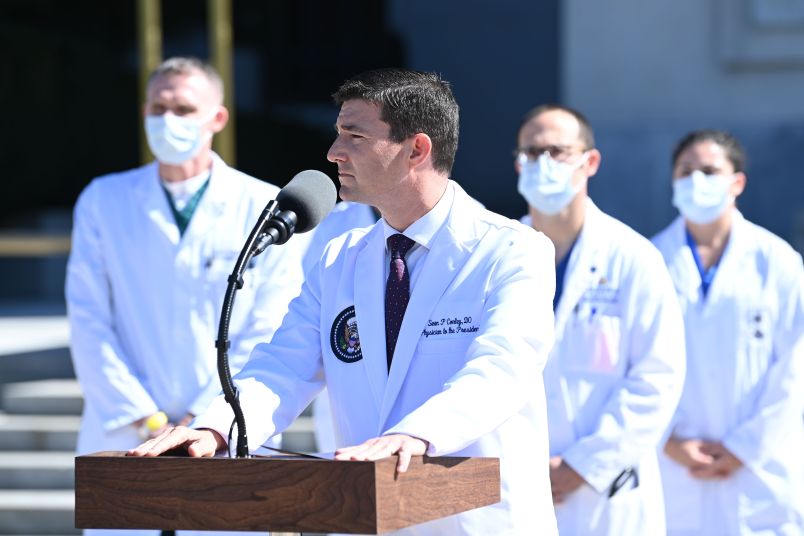White House physician Sean Conley delivered a vague and evasive update on President Trump’s treatment for coronavirus on Saturday, contradicting earlier information about the President’s diagnosis and leaving many unanswered questions.
Standing in front of a team of doctors involved in Trump’s treatment at Walter Reed Military Medical Center, Conley insisted the President is doing “very well.” But the White House doctor offered a baffling new timeline on when the President received an initial positive diagnosis for coronavirus.
Conley revealed that as of Saturday’s press conference Trump was 72 hours into his diagnosis of COVID-19, a date that directly contradicts the President’s own announcement early Friday. Trump told Sean Hannity on Thursday night, after the revelation of Hope Hicks’ COVID-19 diagnosis, that he and the first lady had just been tested and were awaiting results.
Conley’s timeline would place Trump’s positive diagnosis at Wednesday morning. Trump tweeted about his positive diagnosis at roughly 1 a.m. ET Friday, roughly 36 hours ahead of the doctors’ briefing.
After this article was first published, Conley sent out a memo seeking to clean up the messy timeline that appeared to place Trump’s diagnosis days earlier than it was reported. In a memo titled “Timeline Clarification,” Conley said that he had misspoken when he “incorrectly used the term” 72 hours to refer to “day three” of the President’s diagnosis during the Saturday briefing.
“The President was first diagnosed with COVID-19 on the evening of Thursday, October 1st,” the memo says.
Amid the timeline first proposed by Conley was also a refusal to discuss when Trump last received a negative test for coronavirus. His evasiveness adds to the lack of transparency offered by the White House on the President’s situation. The President has claimed he gets tested for coronavirus daily, but when he arrived at the presidential debate Tuesday in Ohio he was too late to receive a test on location, and moderator Chris Wallace said Trump was allowed to proceed based on an “honor system.”
Conley’s lack of clarity on testing raises further questions about whether protocol and precautions were being followed in the White House to protect against the virus’ spread with regular testing, as a growing list of officials in close contact with the president in recent days continue to test positive for COVID-19.
While Conley said that Trump is not currently on oxygen, he refused to say whether the President had received supplemental oxygen earlier in his treatment. The Associated Press reported after the news conference that Trump had received oxygen at the White House before beginning treatment at Walter Reed, citing a source. Conley’s evasion of the question, when pressed multiple times by reporters, raises concern about how the President is faring with the virus.
Conley said Trump that been fever-free for 24 hours, adding “we remain cautiously optimistic, but he’s doing great.” But he refused to give reporters specific information on what the President’s temperature was.
“I’d rather not give any specific numbers, but he did have a fever Thursday into Friday,” he said.
Asked about screenings to detect lung damage, Conley said his team was performing daily ultrasounds on the President and “following all of that.” He would not say whether Trump showed evidence of lung damage.
The entire briefing sought to paint a rosy picture of Trump’s health. However, moments after it ended a source familiar with the President’s health issued an alarming and contradictory statement to the White House press pool.
“The president’s vitals over the last 24 hours were very concerning and the next 48 hours will be critical in terms of his care. We’re still not on a clear path to a full recovery,” the source said.
A day after telling reporters that the President was doing well and “continues to be very energetic,” White House Chief of Staff Mark Meadows was caught on camera Saturday asking to go off record before the anonymous statement was sent out in a White House pool report. A number of reporters attributed the statement to Meadows.
UPDATE: Immediately after the press conference ended and before the anonymous statement was sent out, Mark Meadows briefed reporters without cameras—but he was caught on a feed asking to be off the record. pic.twitter.com/JyrhSmu1Y0
— Olivia Nuzzi (@Olivianuzzi) October 3, 2020
CNN’s Dr. Sanjay Gupta strongly criticized the lack of credible information doctors provided Saturday.
“It was almost more about what he wouldn’t answer versus what he did,” Gupta said, adding that Conley’s avoidance of questions raised red flags about whether the doctor was being forthright in giving a full picture of the President’s condition.
CNN's Sanjay Gupta criticizes vague and evasive briefing from White House doctor on President Trump's condition pic.twitter.com/SVssSRCW7Y
— Talking Points Memo (@TPM) October 3, 2020
The President, who is 74, is at higher risk of complications from coronavirus due to his older age and underlying obesity. He received remdesivir treatment at the military hospital on Friday. The White House said he is expected to stay at Water Reed for the next few days.
After this article was first published, Conley sent out a memo seeking to clean up the messy timeline that appeared to place Trump’s diagnosis days earlier than it was reported. In a memo titled “Timeline Clarification,” Conley said that he had misspoken when he “incorrectly used the term” 72 hours to refer to “day three” of the President’s diagnosis during the Saturday briefing.
“The President was first diagnosed with COVID-19 on the evening of Thursday, October 1st,” the memo says.







I wonder if White House officials regret lying so much for years that now, when they really could use some credibility, the bottle is empty.
Funniest thing you’ll read all day:
Given the White House propensity for lying, this probably means they’re likely fitting someone for a toe tag as they speak.
if he’s doing great why isn’t he tweeting?